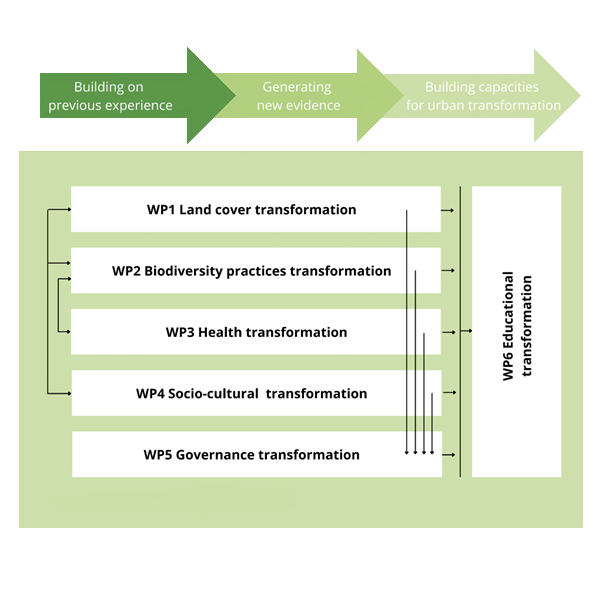METHODOLOGIES
COOLSCHOOLS combines natural, bio-medical, social, and education sciences and rely on participatory and co-creation methodologies to unravel the specificities of each context and to find common patterns related to the transformation capacities of nature-based climate school shelters.
methodological approach
COOLSCHOOLS’ transdisciplinary approach combines the perspectives of natural sciences (urban biodiversity, urban greening), bio-medical sciences (cognitive and behavioural development), social sciences (ocio-cultural perceptions, inclusive governance), and education science (climate change education). We use a novel mixed-method approach that combines quantitative and qualitative methodologies from different disciplines, including participatory and co-creation methods, to co-produce new knowledge that enhances our understanding of the critical transformation capacities of nature-based climate shelters in school environments, reaching a holistic assessment.



Accessibility and equity
(WP1)
Led by VUB, this WP spatially and participatively examines the land cover transformations and associated accessibility implications of the implementation of school nature-based climate shelters and other NBS around school environments. More specifically, this WP will:
- Map the spatial patterns of school climate shelters and related NBS in the studied cities.
- Examine potential inequities in the access to climate shelters co-benefits across the sampled schools considering distributional differences in terms of socio-demographic vulnerability and other equity dimensions.
- Assess spatially the use patterns and perceived benefits of climate shelters by different user groups.
Led by CNRS, this WP aims to draw a baseline on the role of nature-based climate shelters in school environments as educational territories in biodiversity management, assessing the needs and potentials to initiate, renew and diversify a corpus of knowledge and practices in the context of the study sites. To do so, WP2 will:
- Identify the level of knowledge of biodiversity of school users (pupils, parents, teachers) as well as their perception and representations about biodiversity in the school environments.
- Develop inventories of the faunistic and floristic diversity in schoolyards and related management practices.
- Assess the role of schoolyards’ vegetation for urban connectivity at three scales: school, neighborhood, city.
- Enable biodiversity transformation capacities of climate shelters’ users through a Citizen Science programme.
Biodiversity practices
(WP2)
Cognitive and behavioral development
(WP3)
Co-led by UAntwerp and UHasselt this WPl unravels health transformation capacities of school climate shelters by analyzing the associations of the exposure to climate shelters with children’s cognitive development, and behavioral and emotional problems, generating and spreading evidence on the contribution of contact with nature at school to the well-being of our future societies. WP3 will:
- Elaborate cognitive development and behavioral questionnaires and the specific protocols for ethics.
- Engage parents and pupils in assessments of cognitive development and behavioral and emotional problems.
- Assess the associations of cognitive development and behavioral and emotional problems with measures of school climate shelters, accounting for residential NBS.
- Share, reflect and contribute to scientific outputs on health assessments with school climate shelters’ users.
Led by ITC-UT, this WP investigates the role of perception of quality and safety of school climate shelters to determine the capacity of these NBS to initiate socio-cultural transformations of school environments and wider neighborhoods through exploring and validating the interactive approach of Fuzzy Cognitive Mapping (FCM) with users. Specifically, the WP will:
- Identify the state-of-the-art in the relationship between perceived safety and quality/amenity characteristics of climate shelters and related NBS interventions.
- Unearth the impact of amenities/qualities and safety aspects on the current and potential public space and climate shelters use.
- Analyse the FCM network data as scenarios and identify the potential of certain qualities of the climate shelters in initiating a socio-cultural transformation of the school environment and neighborhood.
- Share and reflect with the school community about climate shelters safety and quality characteristics.
Safety and qualities
(WP4)
Inclusive governance
(WP5)
Led by UOC, this WP studies and determines under what conditions school climate shelters can enable governance practices towards urban transformation guaranteeing inclusivity and power sharing between stakeholders. WP5 will:
- Examine the diversity and challenges of governance arrangements of European schools with NBS interventions in school environments.
- Understand the relationships among stakeholders involved in school climate shelters and shed light on potential alliances, conflicts and enablers/barriers for collaborative governance.
- Guide deliberative processes to reflect and develop a co-management path towards inclusive stewardship of school climate shelters.
- Develop guidelines that inform the design, implementation and management of transformative climate shelters with urban planners, policy-makers, entrepreneurs and users.
Led by European Schoolnet, this WP leverages good practices and learnings on the transformation capacities of school climate shelters, promotes them to teachers through capacity building activities and ensure the outreach to Ministries of Education (MoEs), so European schools can benefit from knowledge and tools generated. Specifically, WP6 will:
- Guide European schools to become climate shelters based on WP1-5 evidence and help students, teachers, and other actors understand the core steps needed, as well as the constraints in the process.
- Train teachers on how to use school climate shelters interventions for educational purposes and help them introduce their co-benefits to their students while engaging them in the implementation of climate shelters in their schools.
- Disseminate best practice on climate shelters.
- Produce the recommendation for MoEs to ensure that project outputs are taken up by those developing STE(A)M education strategies for schools and other decision makers on urban climate adaptation.
Education for climate solutions
(WP6)
